






When I started working at Gardener's Supply in the 1990s, my Vermont backyard was pretty green—with grass. Today, there's just a tiny bit of the original lawn left. Most of the available space has given way to trees, shrubs, perennials, annuals and stonework. Watch a slideshow of my garden in Burlington, VT.
In addition to my work at Gardener's Supply, I work in the gardening division at Church Hill Landscapes. In that role, I maintain dozens of gardens and learn a lot in the process. I believe that all gardening is good gardening.
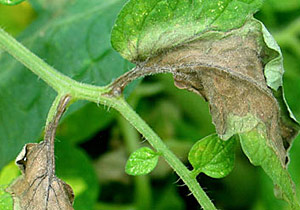
Late blight on a tomato plant. Photos: Courtesy of Meg McGrath, Cornell University
LATE blight, a disease that strikes tomatoes and potatoes, can quickly ruin an entire crop — and provide a source of infection for other plants. It is critical that gardeners understand that late blight is not like other tomato and potato diseases. Many other diseases affect these crops in home gardeners, but most of them only affect leaves or cause limited damage to fruit, and while they may reduce the harvest, they generally don't cause a total loss. Furthermore, because most pathogens are not readily dispersed by wind, their effects are localized. Late blight, on the other hand, kills plants outright, and it is highly contagious. Its occurrence in your garden can affect other gardens and farms due to the wind-dispersed spores.
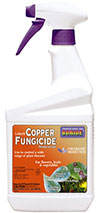
Copper spray
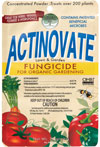
Actinovate
The USA Blight web site tracks the occurance of late blight in real time. Check the site regularly during the growing season. When late blight is detected in your region, consider a weekly prevetative spray.
Cornell plant pathologist Meg McGrath suggests using Actinovate (which contains the beneficial bacteria Streptomyces lydicus) as a preventative spray, and adding a copper-based product, such as our ready-to-spray Copper Fungicide, when late blight is present.
The fungus, (Phytophthora infestans), that causes late blight is aptly named: phytophthora in Latin means "plant destroyer." Infected plant tissue dies. Outbreaks spread quickly under favorable conditions because the pathogen can produce huge numbers of wind-dispersed spores. Once a plant is infected, it must be destroyed.
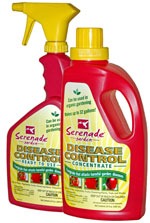
Thousands of commercial growers use Serenade Garden Disease Control to control foliar diseases, because it's so safe you can spray and harvest the same day.
In the last few years, late blight has become a major threat to both home gardeners and commercial growers. It's important for gardeners to be aware of this disease so they can act quickly. Unfortunately, there's no silver bullet for control. The key is to plant wisely, be prepared, be alert and learn to distinguish late blight from other common diseases.
Choose the right variety: Though no tomato varieties are completely immune to late blight, plant breeders are now developing varieties that are resistant to infection by the late blight fungus. So, when it's time to decide which varieties to plant, keep an eye out for these. If you can, start your own plants from seed or buy transplants from a trusted local source. You might also want to plant some varieties that mature early so if late blight does strike, you may still get a harvest.
Prevent overwintering: Fortunately, the fungus that causes late blight needs living tissue to survive over the winter, so it can't overwinter on tomato cages or supports. However, infected potatoes (the other plant that gets late blight) can carry the disease through the winter. Be sure to destroy any volunteer potato plants that come up. If you plant potatoes again, be sure to buy seed potatoes that are certified as disease-free.
Give plants space: If possible, avoid planting tomatoes and potatoes where you had them last year. Be sure to give plants plenty of space, based on recommendations for the variety. Maximizing airflow and light around the plants will help them resist disease. Make use of trellises and supports that will keep the vines off the ground.
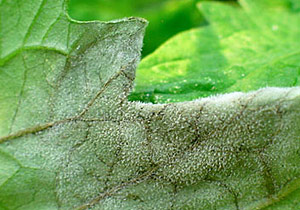
The fuzzy growth on the underside of this tomato leaf indicates that the late blight fungus is growing and producing spores.
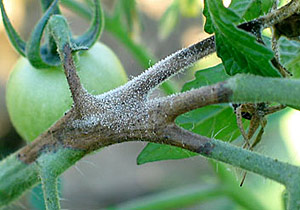
Late blight stem lesions
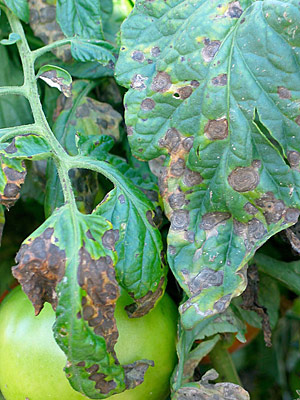
Early blight: Symptoms first appear on older leaves near the base of the plant. Note the "target" appearance of concentric rings.
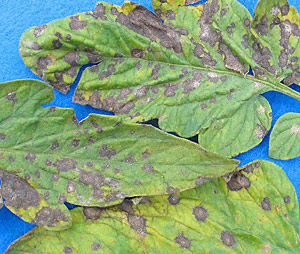
Septoria leaf spot: Symptoms of this disease usually first appear on the oldest leaves, after fruit start to ripen.
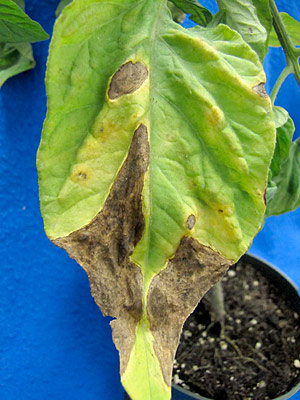
Drought stress: This physiological injury can be distinguished from late blight by the lack of the fuzzy, spore-producing growth and the lack of stem lesions.
Avoid watering from above: Using soaker hoses or drip irrigation keep foliage dry, which makes it more difficult for late blight — and other diseases — to spread. Avoid overhead watering techniques (sprinklers). Water early in the day so the foliage can dry before nightfall.
Be alert: Learn to recognize the weather conditions that foster the spread of late blight. The disease spreads rapidly in cool wet weather, whereas dry weather tends to hold back the disease. The USA Blight website tracks the occurence of late blight in real time. Check the site regularly during the growing season. Your local cooperative extension may be a good source of information, too. Stay in touch with gardeners in your area so you'll know right away if late blight is near. When late blight is detected in your region, consider preventative spraying.
Spray preventively, if necessary: The key word is preventively. Once plants are infected with late blight, it's too late to save them. Research is ongoing in determining the best organic options. Cornell plant pathologist Meg McGrath suggests using Actinovate (which contains the beneficial bacteria Streptomyces lydicus) as a preventative spray, and adding a copper-based product, such as Copper Fungicide, when late blight is present. Before using any products, read the label and use them accordingly. In most cases, effective protection requires that plants be sprayed as often as weekly throughout the growing season. Remember that while these sprays can help reduce the likelihood of infection, you still need to monitor plants closely.
Know it when you see it: Make sure you know what late blight looks like. Two other diseases, early blight and septoria leaf spot, are similar but unlikely to kill your plant, and drought-stressed plants can show similar symptoms. The images at right can help you distinguish them.
If treated plants show signs of continuing infection or if unsprayed plants succumb to late blight, take action. Pull up the plants and either seal them tightly in a trash bag, or secure them under black plastic, where the sun's heat can kill the spores. Do not compost blight-infected plants. If left unattended, the disease will spread quickly from your plants to those of your neighbors and local farmers. Please, garden responsibly!
Copyright © www.100flowers.win Botanic Garden All Rights Reserved